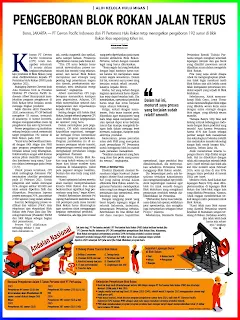The warming of world oil prices in recent weeks is believed to be able to increase the enthusiasm of the oil and gas industry in the country, which had dimmed due to the Covid-19 pandemic.
Head of Program and Communication Division of the Special Task Force for Upstream Oil and Gas Business Activities (SKK Migas) Susana Kurniasih said the increase in oil prices would improve the domestic investment climate.
"SKK Migas continues to coordinate with KKKS to support investment realization," Susana Kurniasih said.
She continued that the upstream oil and gas industry has a high risk so that every project activity is carried out based on predictions of sufficient oil prices.
According to her, although oil prices have crawled up until now Indonesia's upstream oil and gas work plan is still running in accordance with the 2021 work program & budget (WP&B).
"If there are KKKS on the way to add investment activities even though they are not in the WP&B that year, SKK Migas will facilitate it," She said.
Based on the 2021 WP&B, the G&G study is targeted at 116 activities. The 2D seismic survey is targeted to be 4,569 kilometers (km), while the 3D seismic survey is targeted to be carried out along 1,549 km.
Meanwhile, exploration well drilling is targeted at 48 wells, and development well drilling is targeted at 616 wells. Workover activities throughout this year will be carried out as many as 615 wells and followed by well service activities as many as 26,431 activities.
Susana said that until May 2021, domestic upstream oil and gas investment is still running according to the target and there has been no increase.
"The realization is at US$3.11 billion, still on the track," She explained.
NOT SIGNIFICANT
Meanwhile, the founder of the Reforminer Institute, Pri Agung Rakhmanto, said that basically, the scale for the amount of investment from upstream oil and gas actors in the country is limited, namely that the majority of the investment disbursed is only about maintaining existing production.
The unfriendly upstream oil and gas investment climate in Indonesia has made investors reluctant to disburse their funds to start new upstream oil and gas projects in Indonesia.
"The investment surge will only exist if for example there is a large-scale exploration or a large-scale project. If there is nothing new and the scale is not large, it is only about maintaining the lifting level, so it will dwell on the current figures," he told Business.
The Executive Director of Energy Watch Mamit assessed that investors are still waiting for developments from the movement of world oil prices to a stable position. According to him, investors still believe that the increase in oil prices is temporary.
Global economic growth with the current vaccination program is still not optimal. A large number of second and third waves of Covid-19 in several countries with high energy consumption is one of the causes.
"In addition, national economic conditions have not yet grown and there are still domestic restrictions that affect investors more or less. The licensing process, procurement of goods, transportation is still not optimal because this pandemic affects activities in our upstream oil and gas sector," he explained.
Meanwhile, the government's efforts to boost oil and gas investment are actually starting to bear fruit. One of them is from BP Indonesia which increased its investment value by US$4 billion to increase Tangguh reserves in Papua.
Head of SKK Migas Dwi Soetjipto said BP management said it would increase investment in Indonesia through development in the Ubadari Field and carbon capture, utilization, and storage (CCUS).
"We welcome it because it means that the efforts made by SKK Migas and the government to increase investment are paying off," he explained.
Dwi hopes that BP's steps to increase this investment will soon be followed by other contractors, especially since world oil prices will continue to improve.
"The situation of world oil prices recovering faster, even exceeding the average world oil price in 2019, is expected to encourage KKKS to increase exploration activities outside the program agreed in the 2021 work program and budget," he said.
Bisnis Indonesia, Page-4, Wednesday, May 19, 2021









































